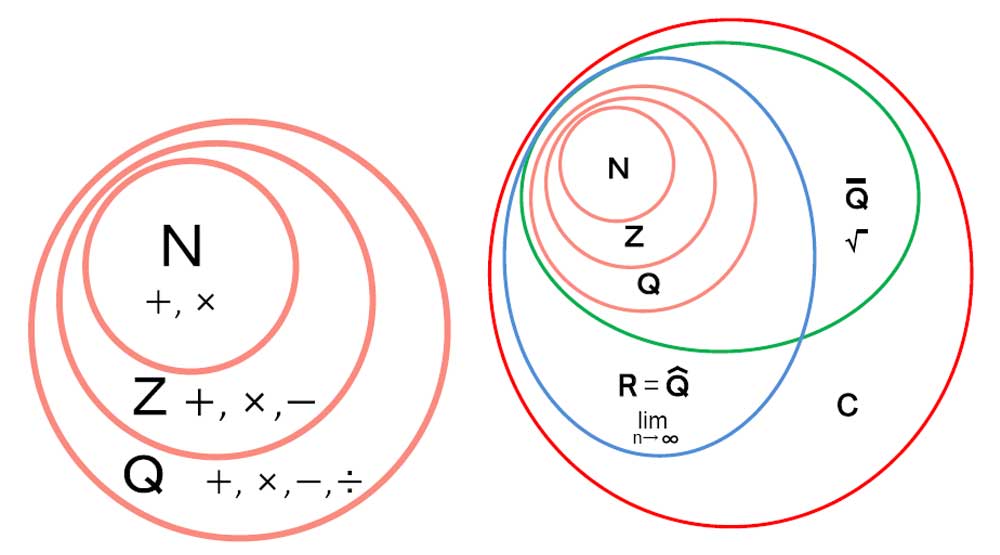Construction of Real Numbers Using Dedekind Cuts

We all know about rational numbers. Informally, these are ratios of integers, i.e., numbers of the form where
and
are integers (with
of course). Any two rational numbers
have a sum
a product
and there is an order relation
such that
or
These operations
and the relation
obey certain properties, which makes the set
of rational numbers an ordered field.
Using this system we can solve most of the elementary problems in mathematics and related disciplines. But there are issues this system can’t address. One such problem is the classical one which the Greeks encountered. Measure the length of the hypotenuse of a right-angled triangle whose other two sides are of unit length. Taking as the required length, the Pythagorean theorem gives us
Now a simple and well-known argument shows that
Let us place the hypotenuse on the
-axis in such a way that one end coincides with the origin
and the other end
lies on the positive
-axis. Then
does not correspond to a rational number; it corresponds to something else.
So we see that the rational numbers are not sufficient for the purpose of measuring lengths of straight line segments; we need new numbers for this. As you have probably already guessed, these new numbers are the irrational numbers. Together with the rational numbers they form the set of real numbers. The operations
and the relation
on
can be extended to
and the resulting system is said to be the system of real numbers. We shall construct this system in two different ways: by Dedekind cuts, and by Cauchy sequences (to be disussed in a subsequent post).
We shall now construct the set of real numbers using what are called Dedekind Cuts. This construction is named after the German mathematician Richard Dedekind. We see that the point does not correspond to a rational number. This means each rational number either lies on the left of
or on the right of
“cuts” the set
of rational numbers into two halves:
the set of those rational numbers that lie on the left of
and
the set of those rational numbers that lie on the right of
. The partition
of
is said to be a Dedekind cut.
The set satisfies the following properties.
- (1)
is a nonempty proper subset of
- (2) If
and
such that
then
- (3) For every
there exists
such that
The second property says that every rational number less than some element of is also an element of
The third property says that
has no largest element. We let
denote the set of those subsets of
that satisfy properties (1), (2) and (3). Observe that each element
corresponds to the Dedekind cut
and conversely. Since we can intuitively see that each Dedekind cut corresponds to a unique point on a straight line and conversely, the elements in
corresponds to the points on a straight line. Observe that every element
satisfies
for all
in other words, every element of
is an upper bound of
But there is no least upper bound because
has no smallest element.
We shall extend the operations and the relation
from
to
to create a system of real numbers. Note that these extensions will really be extensions only if
Strictly speaking, we don’t have
because the element in
are subsets of
whereas the elements of
are not. To get around this we identify
with the set
With this identification we have
Now first we extend the order relation
from
to
For
we define
iff
(recall that
are the subsets of
). Using the properties (1), (2) and (3) one can prove that the relation
is reflexive, anti-symmetric and transitive, and that
or
Thus
is a legitimate order relation on
But why is it an extension of the relation
on
If
then (because of our identification)
A moment of reflection convinces one that
iff
Hence
is an extension of
There is one property that
has which
does not have: The least upper bound property. It says that every non-empty subset of
that has some upper bound has a smallest upper bound. This removes the difficulty we had with
and
in the previous paragraph. It can be easily proved. Consider a non-empty subset
Let
have an upper bound
This means
for every
and hence
for every
To complete the proof, i.e., to show that
is the least upper bound of
one has to prove that
That is easy. This relatively easy proof is an advantage of this construction over the other construction involving Cauchy sequences.
Extension of the operations from
to
are less trivial and are done as follows. For
we define
.
.
- If
then
; and
, if
, or
, if
, or
, if
.
- If
then
; if
, then
.
It can be proved that is an ordered field; because of the least upper bound property
is a complete ordered field. Further, it has
as a subsystem.